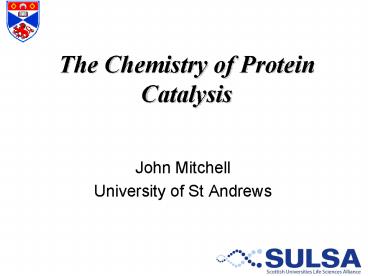The Chemistry of Protein Catalysis - PowerPoint PPT Presentation
Title:
The Chemistry of Protein Catalysis
Description:
Title: PowerPoint Presentation - Scientific Advisory Board Author: J.M. Goodman Last modified by: Dr JBO Mitchell Created Date: 4/24/2003 5:30:11 PM – PowerPoint PPT presentation
Number of Views:228
Avg rating:3.0/5.0
Title: The Chemistry of Protein Catalysis
1
The Chemistry of Protein Catalysis
- John Mitchell
- University of St Andrews
2
The MACiE Database
Mechanism, Annotation and Classification in
Enzymes. http//www.ebi.ac.uk/thornton-srv/databas
es/MACiE/
Gemma Holliday, Daniel Almonacid, Noel OBoyle,
Janet Thornton, Peter Murray-Rust, Gail
Bartlett, James Torrance, John Mitchell
G.L. Holliday et al., Nucl. Acids Res., 35,
D515-D520 (2007)
3
(No Transcript)
4
Enzyme Nomenclature and Classification
5
The EC Classification
- Deals with overall reaction, not mechanism
- Reaction direction arbitrary
- Cofactors and active site residues ignored
- Doesnt deal with structural and sequence
information - However, it was never intended to do so
6
A New Representation of Enzyme Reactions?
- Should be complementary to, but distinct from,
the EC system - Should take into account
- Reaction Mechanism
- Structure
- Sequence
- Active Site residues
- Cofactors
- Need a database of enzyme mechanisms
7
MACiE Database
Mechanism, Annotation and Classification in
Enzymes. http//www.ebi.ac.uk/thornton-srv/databas
es/MACiE/
8
(No Transcript)
9
(No Transcript)
10
Global Usage of MACiE
11
MACiE Entries
12
Difficulties of Hierarchical Classification
- Very similar mechanisms can end up in different
first level classes. - In the case of phosphoinositide-specific
phospholipases C, this is due to a slow final
hydrolysis step occurring in one of the two
enzymes.
13
Classifying Related Enzymes Phosphoinositide-spe
cific Phospholipases C
Eukaryotic (rat) Cell Signalling Multidomain Catal
ytic TIM Barrel EC 3.1.4.11 Hydrolase Final
hydrolysis step Prefers bisphosphate Acid-base
mechanism Calcium dependent
Prokaryotic (B. cereus) Virulence factor Single
domain Catalytic TIM Barrel EC 4.6.1.13 Lyase No/s
low final hydrolysis Disfavours
bisphosphate Acid-base mechanism Not calcium
dependent
14
Difficulties of Hierarchical Classification
- Different mechanisms can occur with exactly the
same EC number. - MACiE has six beta-lactamases, all with different
mechanisms but the same overall reaction.
15
(No Transcript)
16
MACiE Mechanisms are Sourced from the Literature
17
Coverage of MACiE
Representative based on a non-homologous
dataset, and chosen to represent each available
EC sub-subclass.
18
EC Coverage of MACiE
Structures exist for 6 EC 1.-.-.- 57 EC
1.2.-.- 194 EC 1.2.3.- 1450 EC 1.2.3.4
MACiE covers 6 EC 1.-.-.- 54 EC 1.2.-.-
165 EC 1.2.3.- 249 EC 1.2.3.4
Representative based on a non-homologous
dataset, and chosen to represent each available
EC sub-subclass.
19
EC Coverage of MACiE
20
Repertoire of Enzyme Catalysis
G.L. Holliday et al., J. Molec. Biol., 372,
1261-1277 (2007) G.L. Holliday et al., J. Molec.
Biol., 390, 560-577 (2009)
21
(No Transcript)
22
(No Transcript)
23
Repertoire of Enzyme Catalysis
Enzyme chemistry is largely nucleophilic
24
Repertoire of Enzyme Catalysis
Enzyme chemistry is largely nucleophilic
25
Repertoire of Enzyme Catalysis
26
Repertoire of Enzyme Catalysis
27
Repertoire of Enzyme Catalysis
28
Repertoire of Enzyme Catalysis
29
Repertoire of Enzyme Catalysis
We do see a few steps corresponding to well-known
organic reactions but these are the exception.
30
Repertoire of Enzyme Catalysis
31
We divide residue roles into three
categories Reactant Covalently involved in the
reaction step, Spectator Stabilisation,
activation, steric roles, Interaction Hydrogen
bonding etc.
32
(No Transcript)
33
Residue Catalytic Propensities
34
Residue Catalytic Functions
35
Convergent Evolution of Enzyme Function
N.M. OBoyle et al., J. Molec. Biol., 368,
1484-1499 (2007)
D.E. Almonacid et al., PLoS Computational
Biology, accepted
36
We use a combination of bioinformatics
chemoinformatics to identify similarities between
enzyme-catalysed reaction mechanisms
37
Similarity of Overall Reactions Compare Bond
Changes
38
Similarity of Mechanisms Compare Steps
Just like sequence alignment!
We can measure their similarity
39
(No Transcript)
40
Carrying out an analysis of pairwise similarity
of reactions in MACiE ...
41
Find only a few similar pairs
42
Identify convergent evolution
43
Check MACiE for duplicates!
44
Mechanistic similarity is only weakly related to
proximity in the EC classification
45
EC in common
0 -.-.-.-
1 c.-.-.-
2 c.s.-.-
3 c.s.ss.-
46
Similarity of Analogous Reactions
- We take all possible pairs of analogous enzyme
reactions from MACiE 2.3.9 - Analogous means that they carry out similar
functions (EC 1.2.3.- conserved) ... - ... and that the enzymes are not homologous
- We find 95 analogous pairs (convergent evolution).
47
(No Transcript)
48
(No Transcript)
49
(No Transcript)
50
43 out of 95 pairs that are analogous according
to EC have no significant reaction or mechanistic
similarity
Shared EC sub-subclass and Bond Change based
reaction similarity are quite different criteria.
51
(No Transcript)
52
One third of analogous pairs with significantly
similar overall reactions have significantly
similar mechanisms.
53
(No Transcript)
54
For analogous pairs, we find that mechanistic
similarity is less than overall similarity
(almost always) these lie in the lower triangle.
55
Conclusions for Analogous Enzymes
- Conservation of EC sub-subclass does not imply
quantitative reaction similarity. - One third of analogous pairs with significantly
similar overall reactions have significantly
similar mechanisms. - Mechanistic similarity is less than overall
similarity (unlike homologues).
56
ACKNOWLEDGEMENTS
Dr Gemma Holliday Dr Daniel Almonacid Dr Noel
OBoyle Prof. Janet Thornton (EBI) Prof. Patsy
Babbitt (UCSF) Dr Peter Murray-Rust Dr Florian
Nigsch
57
ACKNOWLEDGEMENTS

